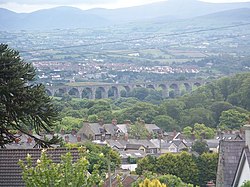Bessbrook
| Bessbrook Irish: An Sruthán[1] | |
| County Armagh | |
|---|---|
 From the east, with the Craigmore Viaduct in the foreground | |
| Location | |
| Location: | 54°11’45"N, 6°23’40"W |
| Data | |
| Population: | 2,420 (2001) |
| Post town: | Newry |
| Postcode: | BT35 |
| Dialling code: | 028 |
| Local Government | |
| Council: | Newry, Mourne and Down |
| Parliamentary constituency: |
Newry & Armagh |
Bessbrook is a village in County Armagh. It lies about three miles north-west of Newry and near the main Dublin–Belfast road and Dublin-Belfast railway line. Today the village of Bessbrook straddles the three townlands of Maghernahely, Clogharevan and Maytown. Bessbrook is near Newry railway station.
During the late 20th century some of the worst violence of "the Troubles" took place near the village and it became a military zone with a large garrison. The small village became the busiest (military) heliport in Europe.
History
Bessbrook is named from Elizabeth or Bess Nicholson, wife of Joseph Nicholson whose family had carried on a linen business in the district from 1806 until 1845. The 'brook' is a stream which runs through the outskirts of the village.
Bessbrook was founded by John Grubb Richardson in 1845 as a 'model village', with spacious streets and squares surrounding a large linen mill owned by the Quaker Richardson family. As a social experiment it is similar to the model of the better-known Bournville company town founded by the Cadbury family near Birmingham, however it predates this development by more than 30 years. It is likely that the precedent on which it was based was the industrial village at Portlaw, County Waterford, Ireland, founded in 1825 by the Quaker Malcolmson family.
Among the principles on which the village was based was a philosophy of "Three P's": there should be no public houses, no pawn shops, and consequently no need for police. It was John Grubb Richardson's belief that without a public house there would be no need for a pawn brokers or police station. To this day there are no public houses in the village. Nor are there any pawn shops, although nowadays there is a police station. In 1885 the hydro-electrically powered Bessbrook and Newry Tramway opened.
At one time, Bessbrook linen was among the finest in the world, and the linen mill provided most of the employment in the village. Tenement houses were constructed for the mill workers, many of which were of such good quality that they are still inhabited today. Each house also had an allotment garden for the growing of vegetables, and the area of the village where they were situated is still known as 'The Gardens', although the allotments themselves have been replaced by further housing. Most of the buildings in the village are constructed of granite, which is abundant locally.
In the frequently segregated communities of Northern Ireland, Bessbrook is an unusually mixed village, with representation of Anglican, Methodist, Presbyterian and Roman Catholic denominations. The village also has a Quaker meeting house. This is set in the demesne of The Woodhouse, which was inhabited by the Richardson family until the 1980s, and of Derrymore House – also a Richardson property until bequeathed to the National Trust, it was once the home of Isaac Corry MP. The area has been designated an historic park.[2]
Places of interest
- On the outskirts of the village is John Macneill's Craigmore Viaduct, known locally as the Eighteen Arches, built in 1851. The viaduct still carries the Dublin-Belfast railway line and with eighteen, 60-ft-high arches, spanning about quarter of a mile, it was for a long time the longest bridge in Ireland. Constructed from local granite it makes for great distinction in the area.
- Derrymore House, a National Trust property open to the public, is nearby. It is an 18th-century thatched house set in over 100 acres of beautiful parkland and woodland. The Act of Union 1800 was drafted in the drawing room of the house in 1800.
References
- ↑ Bessbrook/An Sruthán, Placenames Database of Ireland
- ↑ "Banbridge/Newry and Mourne Area Plan 2015 – Draft Plan August 2006 – Volume 3 Newry and Mourne District Proposals" (PDF). The Planning Service. p. 147. http://www.planningni.gov.uk/index/policy/dev_plans/devplans_az/bnm2015-vol3-newry-mourne.pdf. Retrieved 8 August 2009.